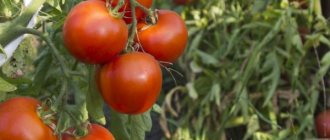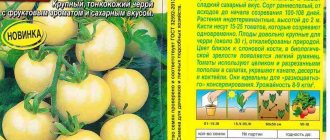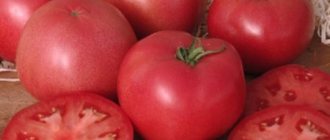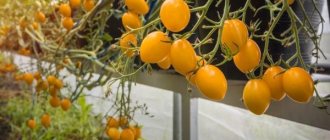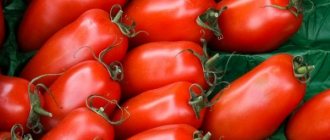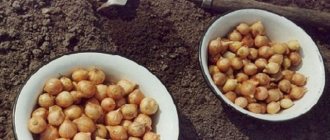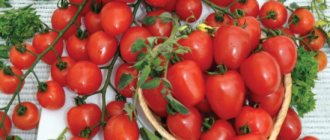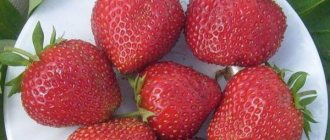The hybrid tomato “Crystal F1”, bred by French breeders and recommended for cultivation in greenhouses, hotbeds and open ground, received excellent reviews from gardeners.
Tomatoes "Crystal F1" are an all-season, early-ripening, cluster hybrid. The period from sowing seeds into the soil until the ripening of the first fruits is 90-105 days. The bush is tall, the internodes are short, the inflorescence is simple. The stem is thick. The leaf is pinnate and light green. The first inflorescence is formed above the 5-6th leaf. Each inflorescence has 8-10 fruits. “Crystal F1” is a tall and high-yielding variety, so it definitely requires tying to a support, and it is also recommended to remove the stepsons. To grow a strong bush, it is formed into one or two stems.
Fruit characteristics
Description: the “Crystal F1” tomato has fruits weighing 120-160 grams, round, even, dense, red inside and out, uniform in color and the same size. Inside the tomato are three small seed chambers containing small seeds. The wall thickness of the Crystal F1 hybrid is 6-8 mm, this ensures a high-quality presentation and good preservation during transportation. Tomatoes of this variety are not susceptible to cracking. The brush matures completely, so you can harvest the crop with brushes.
The weight of one “Crystal F1” brush can reach 1.5-1.6 kg.
Tomato Crystal f1: variety description
| Variety name | Crystal f1 |
| general description | Early maturing, indeterminate hybrid for open ground and greenhouses |
| Originator | France |
| Ripening period | 89-96 days |
| Form | The shape of the fruit is round, smooth or with a slight degree of ribbing |
| Color | Red |
| Average weight of tomatoes | 130-160 grams |
| Application | Versatile, good for canning |
| Productivity of the variety | 9.5-12 kg per square meter |
| Features of cultivation | Standard agricultural technology |
| Disease resistance | Resistant to nightshade diseases |
The tomato hybrid Crystal F1 is included in the State Register of Russia for the Central Black Earth region, recommended for growing in greenhouses, greenhouses and under film.
The Crystal F1 variety was bred by breeders from the French agricultural company Clause. The bush of the plant is of an indeterminate type, reaching a height of 145-155 centimeters. Read about determinate varieties here. Refers to early ripening varieties of tomatoes. The plant must be tied to a vertical support, and it is also recommended to carry out pinching.
The hybrid shows the best yield when the bush is formed with two stems. Fruiting begins 89-96 days after planting tomato seeds for seedlings. A bush with a medium number of light green, thin, feathery leaves. Active formation of tomato clusters begins after the fourth leaf.
Crystal f1 tomatoes are resistant to Verticellium and Fusarium wilt of tomatoes, gray leaf spot, as well as tobacco mosaic virus.
The country where the hybrid was bred is France. The shape of the fruit is round, smooth or with a slight degree of ribbing. Unripe fruits are light green, ripened fruits are juicy, classic red for tomatoes. The average weight of tomatoes is 130-140 grams, with good care and feeding up to 160 grams.
You can compare the weight of fruits with other varieties in the table below:
| Variety name | Fetal weight |
| Crystal f1 | 130-160 grams |
| Doll | 250-400 grams |
| Summer resident | 55-110 grams |
| Lazy | 300-400 grams |
| The president | 250-300 grams |
| Brawler | 100-180 grams |
| Kostroma | 85-145 grams |
| Sweet bunch | 15-20 grams |
| Black bunch | 50-70 grams |
| Stolypin | 90-120 grams |
Universal use, the fruits are well suited for canning, good taste in salads and winter preparations. The average yield is 9.5-12.0 kilograms per square meter. Excellent presentation, due to the thick (6-8 mm) walls of the fruit, good preservation during transportation.
You can compare the yield of this variety with others in the table below:
| Variety name | Productivity |
| Crystal f1 | 9.5-12 kg per square meter |
| Nastenka | 10-12 kg per square meter |
| Bella Rosa | 5-7 kg per sq.m |
| Banana red | 3 kg per bush |
| Gulliver | 7 kg per bush |
| Lady Shady | 7.5 kg per square meter |
| Pink Lady | 25 kg per square meter |
| Honey Heart | 8.5 kg per bush |
| Fat Jack | 5-6 kg per bush |
| Broody | 10-11 kg per square meter |
Taste and technical characteristics
The fruits of "Crystal F1" are sweet and sour, fleshy with dense thin skin. This variety of tomatoes is suitable for fresh consumption, in salads, and has proven itself in home canning. The fruits hold their shape well when pickled and salted. To obtain greater shades of flavor, tomatoes of varying degrees of ripeness can be placed in one jar. The paste and puree made from these tomatoes received especially enthusiastic reviews from housewives for their pronounced red color and thick consistency.
See also
Characteristics and description of the tomato variety Olya, its yieldRead
Taste characteristics of tomatoes, application
“Crystal” tomatoes have an interesting taste, which combines pleasantness with a slight sourness. They are juicy, meaty and, despite the thickness of the skin, tender and pleasant to eat.
The fruits will suit the taste of those who prefer to eat fresh, unprocessed products. In light, summer salads they are especially good in combination with other vegetables. The tribe will also appeal to those who like to make snacks, winter preparations, etc. The fruits retain their round shape well when pickled, making the appearance of the snack irresistibly attractive.
When canning, it is recommended to use tomatoes of varying degrees of ripeness, this will give the dish a special, piquant taste.
Note! The most delicious dish made from “Crystal” tomatoes, according to many housewives, is tomato seasoning and paste
Features of cultivation
Tomatoes "Crystal F1" are grown on slightly acidic or neutral soils. Seeds are sown in accordance with the ripening period and weather conditions of the region. Sowing is done to a depth of 1-2 cm and the top layer of soil is lightly pressed.
The first prerequisite for obtaining strong seedlings is picking the seedlings, which is carried out when 2-4 true leaves appear on the seedlings (30-35 days after sowing the seeds). By about 50-60 days, the seedlings reach a height of 25-30 cm. The finished seedlings are planted in beds at a distance of 50 by 40 cm from each other; planting density: 2-3 plants per 1 sq. m.
Growing in a greenhouse or in greenhouses for the “Crystal F1” variety is preferable, since the yield per bush increases from 6 kg in open ground to 10 kg in a greenhouse and 15-18 kg in a greenhouse. A greenhouse plant develops better, since optimal temperature, light conditions, drip watering and fertilizing are constantly maintained there.
Further care of the plant comes down to simple procedures:
- watering every 7-10 days;
- mandatory soil mulching;
- timely application of fertilizers to the soil;
- ventilation;
- loosening and weeding of plantings.
Tomato Stanichnik - description and characteristics of the variety
Tomatoes belong to the nightshade family. Experts have developed many varieties, each of them has individual characteristics. Tomatoes of the Stanichnik variety are the development of Russian scientists twenty years ago. Tomatoes were included in the register for propagation in open ground. Tomatoes are recommended for growing on large acreage.
Advantages of the variety
The main feature of the variety is its high yield. Tomatoes have excellent taste, and the fruits ripen almost at the same time. Stanichnik tomatoes can be harvested by mechanization, which is an important criterion for harvesting from farmers' fields. There is also the possibility of rare fees. Tomatoes tolerate transportation well without significant loss or deformation of the fruit.
Description of the variety
Low-growing bushes reach a height of 48 to 55 cm. The smooth leaves are green in color, the surface has a slight corrugation. Sown seeds produce ripe fruits in 95-100 days. They are collected in tassels of 7-9 pieces each.
Vegetables are used for fresh consumption, for preparing fresh vegetable salads, as well as for all types of preparations. The number of tomatoes harvested depends on the growing region.
Cultivation
It is recommended to sow seeds in mid-March - approximately 10-20 days. First, the seeds are soaked for a day in a solution of potassium permanganate. The soil should be mixed with peat or humus. The seeds are placed in the grooves and moistened. The container with the crops is covered with glass on top. After 5 days, the first shoots will appear. After 2-3 leaves appear, the seedlings are dropped into a separate container. Watering and fertilizing are carried out as needed.
Planting in a permanent place is carried out after hardening the seedlings. To do this, it is taken outside for 10 days, increasing the length of stay. No more than 3 seedlings should be placed per 1 square meter. The planting area should be well lit. The plant is heat-loving, so unfavorable climatic conditions can affect the yield of the variety.
Rules of care
- Feeding the bushes should be done 2 times per season. First, fertilizers are applied after the ovaries appear, then the plants are fed when the harvest begins. Nutrient formulations must contain nitrogen and potassium.
- It is advisable to water the tomatoes in the evening with warm water. Watering is carried out 1-2 times a week. Tomatoes are not very susceptible to soil moisture, but air humidity can affect yield. During fruit ripening, it should not exceed 60 percent. Lack of moisture can lead to the appearance of fungal diseases, the stems will stretch, and the yield will decrease. To avoid such consequences, it is necessary to carry out preventive treatment of bushes with medications.
- Approximately once a week the soil should be weeded to remove weeds. Loosening the soil near the roots will help get rid of harmful insects.
- Chemical preparations that should be sprayed on bushes for preventive purposes will help against pests.
By following all the care rules, you can get the highest possible yield of healthy and very tasty tomatoes.
Gardeners and farmers note that the variety has more advantages than disadvantages. The red, fleshy fruits have earned respect for their taste and versatility.
- Georgiy S., 65 years old:
I have been growing vegetables all my life. I tried growing many different varieties of tomatoes. I liked the variety Stanichnik because it does not require tying or pinching. All fruits are dense and large. Excellent for fresh consumption and for preparing various preparations. My wife always prepares sauces and juice for the winter. All products are of excellent quality. Tomatoes can be stored for a long time, right up to frost. I want to plant more bushes next year. - Nadezhda Anatolyevna, 49 years old:
A friend advised me to plant the Stanichnik variety. The bushes turned out to be low, I didn’t tie them up. I weeded and fertilized all summer, as stated in the growing instructions. The result obtained exceeded my expectations. The tomatoes are very tasty, juicy and meaty. I prepared juice for the whole winter, and left a lot of fresh fruits. Very well stored, no loss.
Fertilization and fruiting
Tomatoes are fertilized for the first time in the phase of active seedling growth, then 10 days after the second ovary begins to flower, and then as soon as the first harvest has been harvested. After the fruits appear on 3-5 ovaries, it is necessary to tear off the lower leaves of the bushes, freeing the stem to the base of the second cluster. This improves the air flow to the plant, it grows better, increases resistance to fungal diseases, and also accelerates the ripening of fruits.
Also, to speed up fruiting, use the following folk remedy: dilute ash (a third of a bucket) in 2 liters of water. Dilute it with 5 liters of boiling water, then mix well and cool the solution. After this, bring the resulting mixture to a volume of about 10 liters, add 1 jar of iodine and 10 g of boric acid. Leave the solution for a day.
See also
Characteristics and description of the tomato variety Pink Souvenir, its yieldRead
You can also speed up the ripening of tomatoes using special ready-made preparations.
Growing seedlings yourself
You can grow Torbay tomato seedlings yourself. The process does not require special knowledge or skills. Seeds are purchased in a special store, and then everything is done as described below.
Deadlines
It is necessary to prepare containers and soil for seedlings in the fall. But sowing is carried out in the spring, most often in March. On the package with seeds it is usually written what period is most favorable for sowing.
The soil
The soil is chosen neutral. You can choose a universal substrate or prepare it yourself by mixing sand and peat in equal proportions. There is an option for another mixture: leaf soil, peat, humus, sphagnum.
Before planting seeds, it is recommended to disinfect the soil. The easiest way to do this is by freezing. If the winter is frosty, then the soil is taken outside for five days, then transferred to the heat for a week, and then again to the cold. If the outside temperature is above -15 °C, then you should use the freezer.
Did you know? Biological relatives of tomato
—tobacco and potatoes. They are all nightshade.
Growing container
As containers, you can use cups, special plastic containers or small wooden boxes - whatever you like.
Some people believe that it is best to use peat pots for seeds. But whatever the container, it must undergo a disinfection procedure.
Seed preparation
Seed preparation includes mandatory disinfection and soaking procedures, as well as selection. Sorting is carried out using saline solution. Once in this liquid, the seeds will behave like this: empty ones will appear on the surface, and full ones will drown.
Next, the soaking procedure is carried out. Prepare a piece of fabric (preferably a light shade so that the seed is visible on it). Seed material is scattered over it and tied in a knot. In this form, the seeds are immersed in warm water (22-25 ° C) for three to four days.
The penultimate stage of preparation is disinfection. To do this, the seed is soaked for a quarter of an hour in a 0.5-1% solution of potassium permanganate. Then rinse under running water. Finally, they are treated with biostimulants.
Sowing seeds
Ready seeds can be planted. To do this, make grooves 1-1.5 cm deep in a container with soil. Seed material is laid out in them, maintaining a gap of 20 mm between each seed. There should be a distance of 30-40 mm between the grooves. Sprinkle the top with a thin layer of mulch or peat. The soil is sprayed with water and the container is covered with film.
Seedling care
For seedlings to appear, they need warmth, so the seedlings are placed in a room with a temperature of +25°C. You will also need good lighting (14-18 hours a day). Water the seedlings once every seven days with settled water at room temperature. When the first shoots appear, the film is removed and the temperature drops to +15°C.
After seven days, the temperature is raised again (to +20°C). With the appearance of one or two true leaves, a pick is made so that the plants do not crowd each other and the root system develops normally.
Important! Every two weeks it is necessary to fertilize with mineral fertilizers. This will speed things up. "greening" of the seedling and gaining strength
«landscaping
»
seedlings and strength gain.
Hardening of seedlings
A week before the planned planting of young plants in the ground, they are hardened off. The procedure is performed as follows: the container with the plants is taken outside and left for 20-30 minutes. The next day, the duration should be increased so that on the last, seventh day, the seedlings are in the air for 2-3 hours.
Advantages and disadvantages
| Advantages | Flaws |
| Early ripening variety | Garter stem |
| Gives excellent yields | When growing in greenhouses, the cost of maintaining the greenhouse increases |
| Resistant to tobacco mosaic, fusarium, verticillium | Picking required |
| Suitable for growing in garden beds and greenhouses | |
| Friendly ripening of fruits | |
| Possibility of harvesting with brushes | |
| Good transportability | |
| Excellent presentation |
Diseases and pests
As mentioned above, the variety is resistant to nightshade diseases. However, information about the main diseases and measures to combat them may be useful. Read about alternaria and late blight of tomatoes, about protection against late blight and varieties resistant to this scourge.
Tomatoes can be threatened by slugs and insect pests - Colorado potato beetles, thrips, aphids, spider mites. Insecticides will help get rid of them.
Gardeners who grew Crystal F1 tomatoes are almost unanimous in their reviews of it. High-yielding, well preserved during transportation, universal use, with an even size and excellent taste of the fruit. For these qualities, gardeners include the variety among the permanent plantings in their greenhouse.
Growing tomatoes
Hybrid "Crystal" is preferably cultivated through seedlings.
How to prepare seeds?
The seed material does not need to be processed in any way before sowing, since all necessary procedures are carried out by the manufacturer immediately before sale.
Sowing seed material
Description:
- The sowing of seed material is started taking into account the ripening time and weather conditions of the growing region. In regions with possible May frosts, seeds for seedlings are sown in the second ten days of April;
- The seed material is buried 1-2 cm, the soil layer is compacted slightly on top;
- Throughout their growth, seedlings need good lighting and moderate watering with warm water from a spray bottle;
- After unfolding 2-3 full-fledged leaves, they begin to pick the seedlings, while simultaneously applying a complete complex fertilizer.
Rules for planting seedlings
Description:
- Upon reaching the age of 55-60 days and a height of 25-30 cm, as well as if there are 5-6 full leaves, you can begin planting in a greenhouse structure;
- Despite the undemanding nature of the hybrid regarding soil type, greater yields can be achieved when grown in slightly acidic or neutral soils. Give preference to beds after legumes, dill, cauliflower and zucchini;
- Tomato bushes are placed at intervals of 40 cm from each other, the row spacing should be at least 50 cm. When replanting, it is necessary to observe the recommended planting density, planting 2 to 3 seedlings per 1 m2.
Disease resistance
The main distinctive feature and undeniable advantage is the resistance of the “Crystal” variety to common diseases among tomatoes: tobacco mosaic, fusarium, verticillium wilt.
The “Crystal” tomato variety is perfect for growing in any conditions, although it is worth considering the fact that the yield of greenhouse plants can be 2 times higher than the yield of plants grown in an open area. Minimal care is required: fertilizing, watering, weeding, loosening. This variety is suitable for beginner vegetable growers, as well as experienced gardeners.
tomato Red bunch - description and characteristics of the variety
Planting and growing
Reviews from summer residents indicate that Crystal F1 tomatoes can be grown in neutral and slightly acidic soils. Sowing is carried out in accordance with the weather and climatic conditions characteristic of a particular region. For seedlings, you need to use pots in which soil is placed. Before sowing, holes are made in the ground 1-2 cm deep. Then the seeds are lowered there and sprinkled with the top layer of soil.
As soon as 2-4 true leaves are formed on the seedlings (this usually happens 30-35 days after sowing the seeds), it is necessary to pick. After 50-60 days, the seedlings reach a height of 25-30 cm. Then the seedlings can be sown in beds at a distance of 50x40 cm from each other. Usually 2-3 bushes are planted per 1 m². From 1 bush grown in a greenhouse, 15-18 kg of tomatoes are harvested, in a greenhouse - up to 10 kg, and in open ground - 6 kg.
After planting in a greenhouse or open ground, it is necessary to properly monitor the plants. This includes timely watering, fertilizing, and establishing light and temperature conditions.
Watering should be drip and carried out once every 7-10 days. An essential element of caring for tomatoes is mulching the soil and feeding it with mineral and organic fertilizers. The greenhouse or greenhouse must be regularly ventilated, and the open and greenhouse soil must be weeded and weeds removed. Summer residents advise using a folk remedy to accelerate growth. Ash is diluted in 2 liters of water, and this mixture is then diluted with boiling water. When the solution has cooled, you need to pour in another 5 liters of water, pour 1 bottle of iodine into it and add 10 g of boric acid. The solution is infused for 1 day, and then poured under the root of the bushes.
Tomato Crystal F1 is a French hybrid that has taken root well in Russia. It is praised by many gardeners due to its excellent commercial qualities, the ability to preserve it, and its rich harvest. The fruits ripen quickly, and you won’t have to wait long for ripe tomatoes.
| Height | Landing location | Ripening time | Fruit color | Fruit size | Origin | Fruit shape |
| Tall | Greenhouse | Early ripening | Reds | Average | Hybrid | Round |


